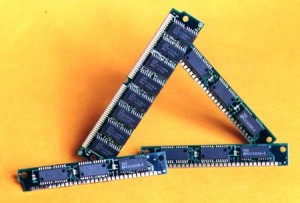Smart Modular Technologies is a smart (and modular) choice
A new year is upon us, and with it, a new set of investing opportunities. Actually, most of them are the same opportunities that existed last year, but the prices have changed and that makes all the difference. Actually, I have been noticing lately that I have been finding fewer attractive opportunities, as a result of a continuing stock market advance. I have been selling certain positions, including Linn Energy and Qwest, and not replacing them. I would rather incur opportunity costs than risk losing money by lowering my standards.
 However there remain some opportunities out there on an absolute as well as a relative basis. One of them is Smart Modular Technologies (SMOD). Smart Technologies makes memory modules, particularly DRAM, and also makes solid state products including hard drives and embedded flash devices. They also perform design work to facilitate integration of their products into their clients’ products, and provide other services such as supply chain management and other services relating to their products. Their current operating focus seems to be moving into Brazil.
However there remain some opportunities out there on an absolute as well as a relative basis. One of them is Smart Modular Technologies (SMOD). Smart Technologies makes memory modules, particularly DRAM, and also makes solid state products including hard drives and embedded flash devices. They also perform design work to facilitate integration of their products into their clients’ products, and provide other services such as supply chain management and other services relating to their products. Their current operating focus seems to be moving into Brazil.
The company’s operating figures paint an attractive picture, with a P/E ratio of 7.3 and a market cap of $373 million. HP, Cisco, and Dell have collectively accounted for roughly half of their sales. Obviously, as they provide for the consumer and enterprise markets, their sales have been fairly volatile, having increased 59% for fiscal year 2010 as compared with 2009, while 2009 sales decreased 34% from 2008. Volatility in DRAM prices also produces a great deal of volatility in sales, and as Smart has recently announced a continuing drop in DRAM prices that is affecting them and all their competitors, which is weighing on their future prospects.
As Smart has cyclical operations, it is difficult to think of a particular year as representative of overall earnings power. As a result, it may be more appropriate to examine what their overall margins have been over the last few years. Gross profit margins were 17.4% in 2006, 17.7% in 2007, 17.9% in 2008, 20.4% in 2009, and 23.6% in 2010. In terms of operating expenses, lately R & D has been up from $15 million in 2006 to $25 million last year. The last five years have also included various nonrecurring or noncash events such as goodwill impairments and restructuring charges. If we remove them, as well as general and administrative costs, we have operating margins of 7.7% in 2006, 8.7% in 2007, 5.9% in 2008, 3.3% in 2009, and 11.5% in 2010, and an average level of 7.4%. Interest has been covered amply in every year, and as Smart Technologies operates in a number of taxing jurisdictions their tax rates have frequently deviated from a kosher 35%. Based on projected sales of roughly $700 million, this produces projected operating earnings of roughly $52 million, which, after roughly $5 million in interest payments and taking out a third for taxes, we have theoretical income of roughly $32 million.
Now, I don’t mean to project that Smart Technologies will actually have net income of $32 million next year, or any year, for that matter, but that is, I think, a fair estimate of their earnings power based on the current situation. Furthermore, given that their five year history includes 2008 and 2009, there could be an argument that the five year averages are lower than their true earnings power, and as a result we could perhaps justify some optimism. At any rate, $32 million set against a $373 million market cap is an earnings yield of 8.6%, which is reasonable, if not particularly attractive. Also, depreciation has been more or less tracking capital expenditures, so there is no additional source of free cash flow.
 What makes this company intriguing, though, is its strong balance sheet that is heavily tilted towards current assets. Based on their recent results, they have $93 million in cash and $179 million in receivables, as well as $103 million in inventory, total $375 million. Total assets come to $482 million, and they have $163 million in total liabilities, of which $81 million is accounts payable. This high level of cash and receivables should give buyers confidence that the existing value is safe. Although their inventory, or at least the DRAM part of it, is somewhat volatile and could be subject to write-downs, the fact remains that current assets minus total liabilities comes to $212 million, more than half of the current market cap.
What makes this company intriguing, though, is its strong balance sheet that is heavily tilted towards current assets. Based on their recent results, they have $93 million in cash and $179 million in receivables, as well as $103 million in inventory, total $375 million. Total assets come to $482 million, and they have $163 million in total liabilities, of which $81 million is accounts payable. This high level of cash and receivables should give buyers confidence that the existing value is safe. Although their inventory, or at least the DRAM part of it, is somewhat volatile and could be subject to write-downs, the fact remains that current assets minus total liabilities comes to $212 million, more than half of the current market cap.
As I stated before, they have recently been focusing their operations on Brazil, and indeed non-US sales represent more than 70% of their total sales. This may be an attractive trait for investors who wish to avoid exposure to the dollar.
The results for the first quarter of fiscal year 2011, which ends in August, are in line with 2010’s excellent results, with nearly $8 million in reported earnings, or $32 million per year. They claim that there was an infrequent and nonrecurring expenditure of $7.5 million for a “technology access charge” for technologies they will be using in their development of solid state products. Now, this amount may be nonrecurring in that they probably do not intend to incur this particular expense again, but it may be recurring in that they will incur technology licensing fees in future. At any rate, this expenditure is directed towards developing more solid state products. Now, on the whole, companies that run diversified lines of business for the sake of diversification alone tend to have their schizophrenia punished by Wall Street, and my holding of Seagate may indicate that I am skeptical that solid state is the inevitable wave of the future–and if it is, it is still hard to tell who will ultimately be the victor. However, it may be in Smart’s interest to lower its exposure to the volatile DRAM prices that caused it to lower its estimates for the year. At any rate, first quarter results do confirm my existing assessment of Smart’s earnings power.
As a result, I can say that Smart is a well-positioned, safe, and reasonably high yielding company with a solid position, and therefore should be considered for portfolio inclusion.
Leave a Reply